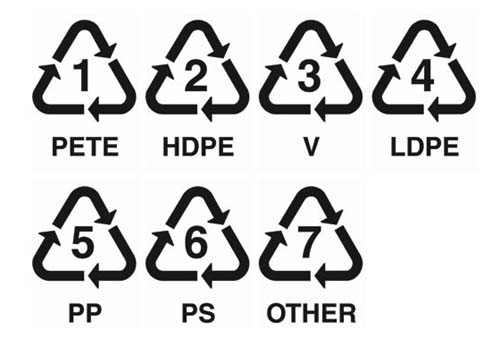Plastics by the number
The Refuse Pledge
Disposable plastics are the greatest source of plastic pollution. Designed to be discarded, straws, plastic bottles, plastic utensils, lids, plastic bottles and so many others offer a small convenience but remain forever. REFUSE disposable plastics! Follow the “4 Rs” of sustainable living: Refuse, Reduce, Reuse, Recycle. Take the pledge! Watch this little advertisement that gets the point across rather well!
Buried in Plastic PSA Plastic Pollution Coalition from Dianna Cohen on Vimeo.
What do those numbers mean, anyway?
Plastic #1 ( PETE OR PET )
This is polyethylene terephtalate, also known as PETE or PET. Most disposable soda and water bottles are made of #1 plastic, and it’s usually clear. This plastic is considered generally safe. However, it is known to have a porous surface that allows bacteria and flavor to accumulate, so it is best not to keep reusing these bottles as makeshift containers. This plastic is picked up by most curbside recycling programs.
Plastic #2 ( HDPE)
This is high density polyethylene, or HDPE. Most milk jugs, detergent bottles, juice bottles, butter tubs, and toiletries bottles are made of this. It is usually opaque. This plastic is considered safe and has low risk of leaching. It is also picked up by most recycling programs.
Plastic #3 ( PVC )
This is polyvinyl chloride, or PVC. It is used to make food wrap, bottles for cooking oil, and plumbing pipes. PVC is a tough plastic but it is not considered safe to cook food near it. There are phthalates in this material–softening chemicals that interfere with hormonal development. You should minimize use of #3 plastic around food as much as possible. Never cook using food wrap, especially in a microwave oven. If the wrap is listed as microwave-safe then I would still not let it touch the food while using it in the microwave. #3 plastic is rarely accepted by recycling programs.
Plastic #4 ( LDPE )
This is low density polyethylene (LDPE). It is used to make grocery bags, some food wraps, squeezable bottles, and bread bags. This plastic is considered safe, but is unfortunately not often accepted by curbside recycling programs.

Plastic #5 ( PP )
This is polypropylene. ( PP ) Yogurt cups and similar wide-necked containers are often made from it, as well as water bottles with a cloudy finish. You’ll also find it in medicine bottles, ketchup and syrup bottles, and straws. This plastic is also considered safe, and is increasingly being accepted by curbside recycling programs.
Plastic #6 ( PS )
This is polystyrene, or Styrofoam, from which disposable containers and packaging are made. You’ll also find it in disposable plates and cups. Evidence is increasingly suggesting that this type of plastic leaches potentially toxic chemicals, especially when heated. I suggest avoiding the use of #6 plastic as much as possible. It is difficult to recycle and most recycling programs won’t accept it.
Plastic #7 OTHER
This number basically means “everything else.” It’s a mixed bag, composed of plastics which were invented after 1987. Polycarbonate falls into this category, including the dreaded BPA. So do modern plastics used in anything from iPods to computer cases. It also includes some baby bottles and food storage containers which resist staining. Use of #7 plastic is at your own risk, since you don’t know what could be in it. You should dispose of any food or drink related product, especially for children, that is known to contain BPA.
To summarize, plastics #2, #4 and #5 are generally considered safe. Plastic #1 is safe too but should not be re-used due to the risk of growing bacteria. Any other plastic should be used with extreme caution, especially around food or drink. The risk is even greater when heating food. For microwaving in particular, remember that microwave safe containers aren’t necessarily healthy. They just won’t melt. In general, it’s better to avoid microwaving plastic entirely and stick to glass.

